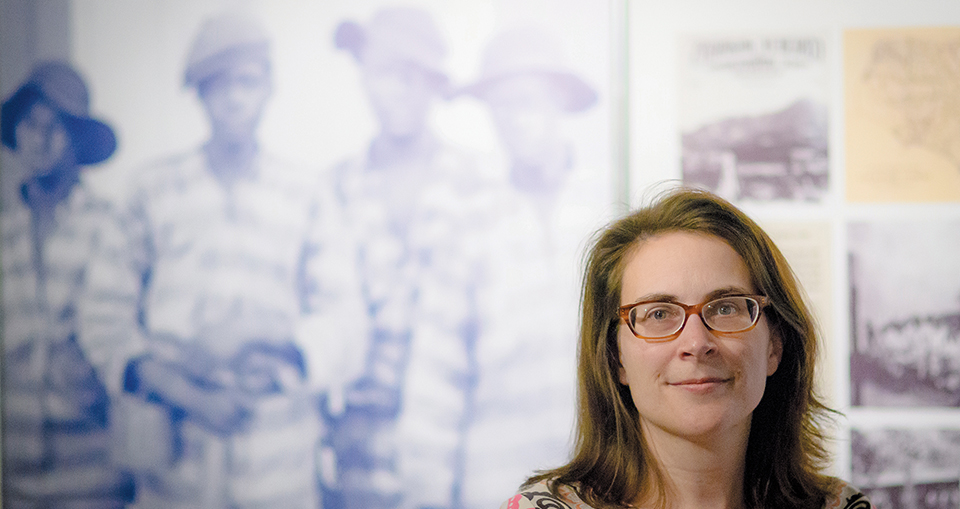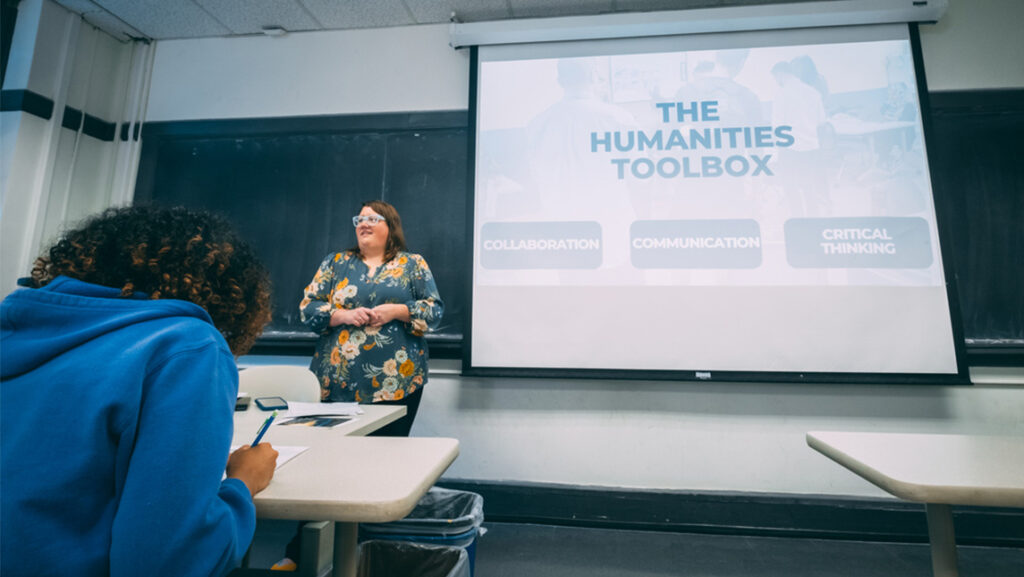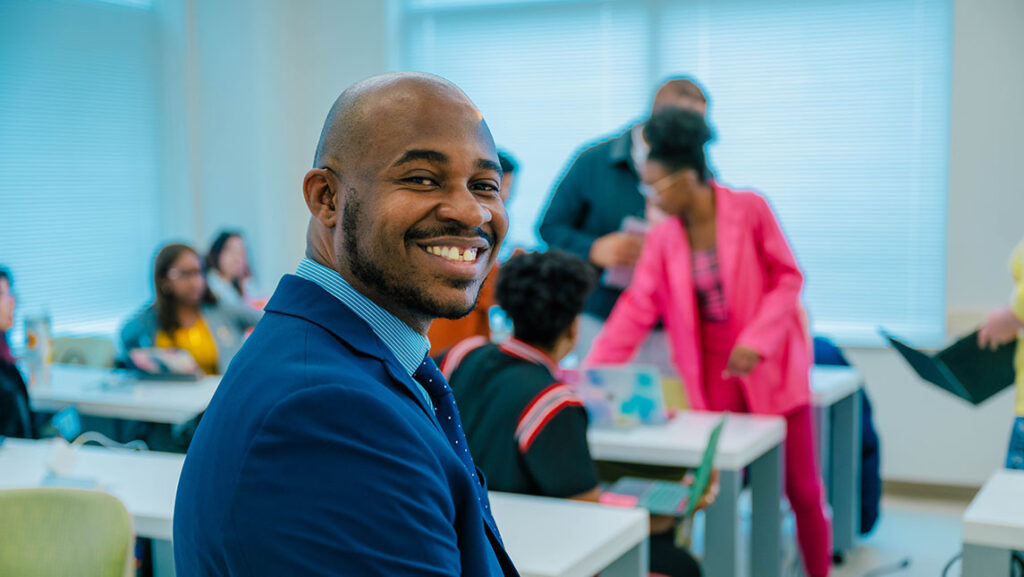Adapted from the spring 2017 UNCG Research Magazine
As the nation’s largest jail, Chicago’s Cook County facility spans eight city blocks and houses 9,000 inmates.
It also has another distinction: by default, it’s the largest mental-health facility in the United States.
To Dr. Anne Parsons, this is not surprising.
Her research shows that as state governments shuttered decades-old, often-barbaric mental asylums starting in the 1950s, society was left with an unintended consequence: the mass incarceration of people with psychiatric disorders. And, in jails and prisons, these individuals rarely get the help they need.
“It’s deeply saddening, but I am optimistic that if we keep bringing this to the public’s attention, perhaps we can break the cycle,” says Parsons, an assistant professor of history.
Her recently finished manuscript, “Asylum to Prison: Deinstitutionalization and the Rise of Mass Incarceration,” delves into this transition and offers guidance on needed reforms. The book, to be published in 2018 as part of the UNC Press series “Justice, Power, and Politics,” is intended for history scholars as well as for professionals who work for prison and mental-health reforms.
Parsons also plans to curate a traveling exhibition on this work for more than 100 libraries, universities, museums, and community centers nationwide. The exhibition, sponsored by the National Library of Medicine and funded by the National Institutes of Health, will likely open in 2019.
“My goal is to share this research with a broader audience and start conversations across the country,” she says.
Parsons’ book opens with the story of the Philadelphia State Hospital at Byberry, which held up to 6,000 people in the mid-20th century, making it one of the nation’s largest asylums. Committed against their will, people stayed for decades — often enduring horrific treatments and abject neglect — without any legal protections for release.
![Last fall, Parsons and graduate students in the museum studies program brought the national “States of Incarceration” exhibition to the International Civil Rights Center & Museum in Greensboro. UNCG and 20 other universities contributed to the traveling exhibit, which explores the roots of mass incarceration. [Photo by Martin Kane]](https://research.uncg.edu/wp-content/uploads/2017/08/Parsons_Ladder_RGB.jpg)
“While the impetus to release people was positive, there weren’t available community services to support them,” Parsons says. As a result, many found themselves in boarding houses — lost, alone, struggling with mental illness, and unable to integrate into society.
At the same time, a perfect storm was brewing: police forces were expanding, the war on drugs was beginning, and there were stricter sentencing guidelines and an upward tick in the criminalization of mental illness. All this led to a rise in mass incarceration.
According to a 2015 article in The Atlantic magazine, “at least 400,000 inmates currently behind bars in the United States suffer from some type of mental illness — a population larger than the cities of Cleveland, New Orleans, or St. Louis.”
Similarly, the National Alliance on Mental Illness estimates between 25 to 40 percent of Americans with mental illness will find themselves incarcerated during their lifetime.
Parsons, who has visited jails and prisons over the years, says today’s psychiatric units bear an eerie resemblance to the macabre asylums of yesteryear. “You’ll find only a handful of psychiatrists on staff — stark rooms with bars on the windows and benches and a TV or two,” she says. “How is it that we keep responding to people in a way that’s not therapeutic?”
Part of the solution could be to redirect some prison funding into mental health and support services, she argues. It has worked before.
When Byberry closed in the 1980s, the Mental Health Association of Southeastern Pennsylvania sued to ensure patients would receive adequate housing and wraparound services. “That closure was an example of how this can be done right,” Parsons says. “It’s about putting people at the center rather than just closing an institution.”
She hopes that research will help build an improved future. “By better understanding these cycles of confining people, we’re in a better place to break them.”
!["The Jumpsuit Project" is a performance-art piece conceived by UNCG MFA student Sherrill Roland [Photo by Todd Turner]](https://research.uncg.edu/wp-content/uploads/2017/08/Roland.jpg)
One of the “States of Incarceration” exhibit guides and community participants was Sherrill Roland, a UNCG MFA student.
In 2013, Roland served nearly a year in prison for a crime he didn’t commit. Today, he has been fully exonerated.
He feels compelled to share his experience in a deeply personal and sometimes shocking way. He wears a bright orange, prison-style jumpsuit around campus.
“The point is to throw people off and to get a reaction,” says Roland, 32. “People pose questions instantly.”
With the support of Assistant Professor of Art Sheryl Oring, Roland conceived of “The Jumpsuit Project” as a performance-art piece to start conversations. His goals are to shed light on what it’s like to serve time, to tackle the stigma of incarceration, and to promote support for those in prison and their families and friends.
“Incarceration was the worst thing I’d ever experienced,” Roland says. “Before it, I was really naïve. I think we can all be caught up in our bubbles, and if something doesn’t affect us personally, we won’t know the inner workings.”
He hopes his project will change that. “Maybe being able to share my story can help people understand what it’s really like.”
“Break the Chain” by Dawn Martin originally appeared in the spring 2017 UNCG Research Magazine.
Learn more at https://his.uncg.edu



